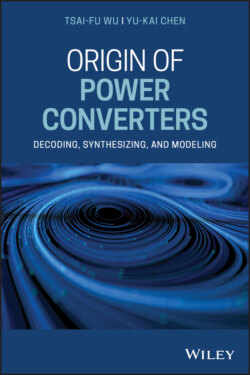Читать книгу Origin of Power Converters - Tsai-Fu Wu - Страница 32
2.2.1 Voltage Transfer Ratios
ОглавлениеFrom power transfer point of view, the resonance approach can describe the derivation of the buck converter with more physical insight. For resonance, it requires at least a second‐order LC network. In addition to the buck converter, there are other two well‐known PWM converters, boost and buck‐boost, each of which is also with a second‐order LC network. As discussed previously, the buck converter is considered as the candidate of the original converter. Thus, let us see if it is possible to evolve buck‐boost and boost converters from the buck converter. For illustrating the evolution, operation mode and transfer ratio of the buck converter need to be discussed first.
Given a buck converter shown in Figure 2.5a and assuming all of the components are ideal, when switch S1 turns on, the voltage across inductor L1 is Vi − Vo, while when switch S1 turns off, diode D1 will conduct, and the voltage across L1 is −Vo, as illustrated in Figure 2.5b. Thus, based on the volt‐second balance principle, we can have the following equation:
(2.1)
Figure 2.5 (a) The buck converter, (b) inductor voltage VL1 and current iL1, and (c) those in DCM operation.
where D is the duty ratio of switch S1 and Ts is the switching period. Since inductor current iL1 never drops to zero, this operation mode is called CCM. From (2.1), we can derive the input‐to‐output voltage transfer ratio below:
(2.2)
If inductor current iL1 drops to zero before turns on switch S1 again, as shown in Figure 2.5c, the operation mode is called DCM. Again, based on the volt‐second balance principle, we can have the following equation:
(2.3)
where d1 is the duty ratio of switch S1, d2 is the duty ratio of diode D1, and (1 − d1 − d2)Ts is the dead time. From (2.3), we have the following input‐to‐output voltage transfer ratio under DCM operation:
(2.4)
If
(2.5)
the operation will be CCM and d1 = D. Thus, the CCM can be considered a special case of DCM. No matter what mode of operation, the configuration of buck converter keeps unchanged. For simplicity and considering most of converters operated in CCM, we will first discuss the evolution of converters based on the voltage transfer ratio under CCM operation.
